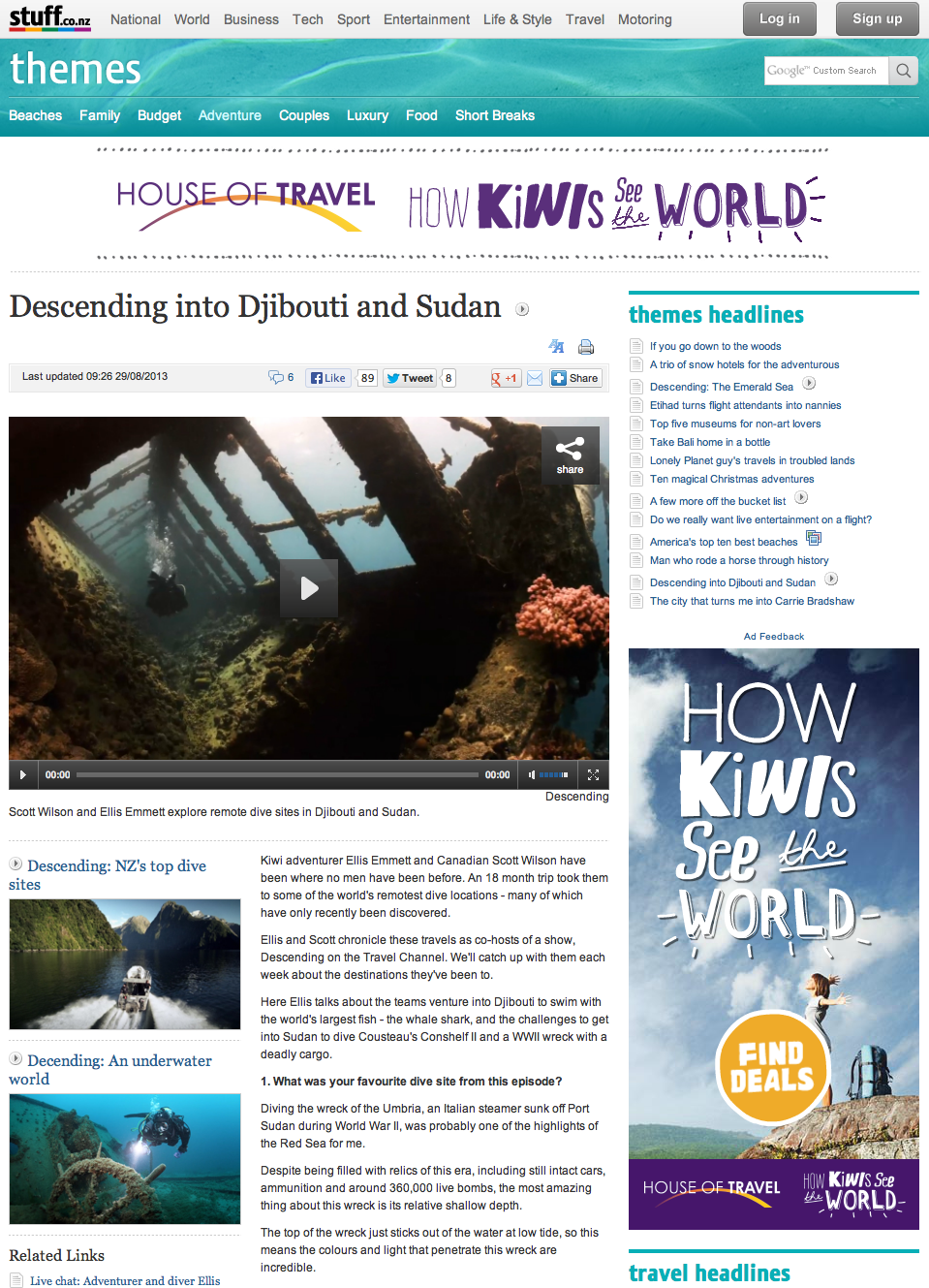
Descending into Djibouti and Sudan
Published on Thursday, August 29th, 2013, under Media
Scott Wilson and Ellis Emmett explore remote dive sites in Djibouti and Sudan.
(click on the above image to watch video link)
Kiwi adventurer Ellis Emmett and Canadian Scott Wilson have been where no men have been before. An 18 month trip took them to some of the world’s remotest dive locations – many of which have only recently been discovered.
Ellis and Scott chronicle these travels as co-hosts of a show, Descending on the Travel Channel. We’ll catch up with them each week about the destinations they’ve been to.
Here Ellis talks about the teams venture into Djibouti to swim with the world’s largest fish – the whale shark, and the challenges to get into Sudan to dive Cousteau’s Conshelf II and a WWII wreck with a deadly cargo.
1. What was your favourite dive site from this episode?
Diving the wreck of the Umbria, an Italian steamer sunk off Port Sudan during World War Il, was probably one of the highlights of the Red Sea for me.
Despite being filled with relics of this era, including still intact cars, ammunition and around 360,000 live bombs, the most amazing thing about this wreck is its relative shallow depth.
The top of the wreck just sticks out of the water at low tide, so this means the colours and light that penetrate this wreck are incredible.
I will never forget swimming down one of the long corridors inside the wreck with the shafts of brilliant light piecing through the portholes, dancing in time to the movement of the water above.
2. How did you get there?
When diving in Sudan we spent about a week on a live-aboard dive boat, the Don Questo.
It was an old fishing vessel that had been converted into a dive boat.
It is sheer luxury to dive this way, as everything is right on hand.
No lugging heavy equipment around on and off boats, vehicles, planes, etc, just anchor up to a dive location for a day or two and drop in over the side.
3. What driving risks were you concerned about in this location?
When wreck diving there are many associated risks and each wreck may have different dangers.
One of the biggest risks is going too deep inside a wreck and then getting lost or silted out and then not being able to find your way back out before your air runs out.
When you are under water it is very easy to get disorientated, as you have very few reference points, your visibility is very low, compared to above water, and you tend to never swim in a straight line.
Inside a shipwreck these factors are magnified.
4. What’s one thing every traveller should try there?
The Red Sea is not just about shipwrecks – even snorkelling you can see incredible marine life and a huge diversity of species and colours.
The water is bath warm and visibility is usually good. Just jump in and explore this incredible underwater world.
5. Did anything go wrong on the dive?
Apart from a few minor stings with jellyfish and fire corral we had no major incidences while filming in the Red Sea… Oh I tell a lie haha – we missed our flight out of Djibouti because we were filming Lake Assal, Africa’s lowest point at 155m (509 ft) below sea level.
And on the way back our vehicle broke down and we missed our flight. The trouble was, it was a ‘once a week’ flight – you can imagine the production dramas his caused!
6. What’s the coolest thing you saw?
Diving within arms reach of the world’s biggest fish – a Whale Shark. These guys truly are gentle giants. I had the opportunity of looking into the eyes of one of these huge yet shy creatures. A truly amazing experience!
Most of our time filming in the Red Sea was either on or under the water, but whenever I got the chance I always went exploring.
For me, travel is about meeting people, experiencing cultures, learning and sharing. I have fond memories (off camera) of walking the streets, photographing the markets and talking with the locals in Sudan.
Watch Descending, Wednesdays, 8.30pm on the Travel Channel.






